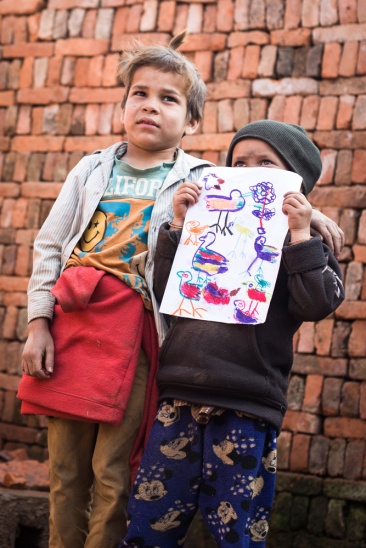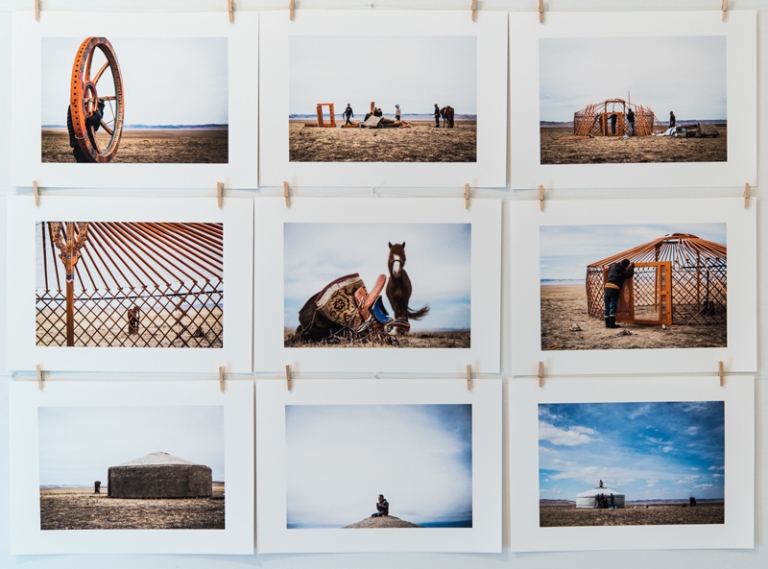 March 19: “White space” is as important in photography as it is in drawing
March 19: “White space” is as important in photography as it is in drawing
As the Castlemaine State Festival continues for another 8 days, I’ll stretch my self-imposed rules for this blog a little to write about a show that opened yesterday, Anna Wilson‘s Cold, which I visited just now.

As with many other exhibitions of local artists’ work during the Festival, this one takes place in Anna’s own house at 121 Gingell Street, Castlemaine, 18th-19th March & 24th–26th March, 10am-5pm.

From October 2014 until mid 2016 Anna and her husband Dave lived in Mongolia and Nepal. Anna, having left academia on hold, found time to photograph…and to draw, so this is not an exhibition of someone’s holiday snaps.
A photographer who also draws is unfortunately a rarity, perhaps now more than ever, though it is something every photographer should at least try to do, to discover what drawing with other media might teach us artists of Talbot’s Pencil of Nature; light.
Too hard? Take a leaf from the sketchbooks of the child workers of the brick kilns of Kathmandu whom Anna describes on her blog, Felt Boots and Stilettos.
Today, even though Anna had a few friends they had met in Nepal over for tea (in fact, the very people who worked with those children), she found the time to chat about her pictures with me. Her warmth and candour were a contrast to her subject; the cold she experienced in that country, a place still mysterious to me as it must be to many others, but one she clearly loved as much as its climatic conditions!
The exhibition was weighted toward photography in terms of devotion of wall space to the medium, but as there were full sketchbooks included for perusing as well as the framed drawings the representation of both was equal. Though segregated to different parts of the show, a comparison of both kinds of artwork was easily made, and revealing.

Anna uses a pen to make her on-site observational drawings with no preparatory pencil sketching. She does not work from photographs;
Drawing in my sketchbook is my happiness and my wellness. While I sketch I am nowhere else, just there. It is my stillness and my joy. When I combine this with a pot of tea, some company (of people or sometimes gorgeous plants) or a coffee, I am perhaps in my most content place. Add a storm outside, a freezing wind, or a grey fog, and it would be even better again – a sketchbook, a warm cosy room, and a storm – my idea of perfection. There is something different about drawing in a book than drawing on paper. Pages in a book don’t seem as disposable. There is also an order, so the book becomes something of a story, or at least a collection curated by time. There is also freedom that comes with drawing in a book – it feels like it is just for me, not for the world – and this allows for spontaneity…
When my Leaving Certificate year at school was coming up, my fondest wish was for a Rapidograph tech pen, the 1960s equivalent of a high-end designer’s Sharpie, but then hideously expensive. My dear mother, then the sole breadwinner on a nurse’s wage, bought me one for my birthday, and I can confirm that to use one, as Anna points out, is to visualise your subject on the paper, and commit.
Her photographic eye is surely the reason for her success in making these beautifully composed images as she draws them on the spot, and indeed some contain ‘photographic artifacts’.

Here, a handsomely bearded chap in a duffle coat and cap is waiting for his coffee order and while Anna is drawing him, he gets his double-shot espresso and heads out the door. But she keeps drawing, filling in what is behind him; an uncommunicative trio, one of whom is texting under the table. Any photographer would understand this is exactly what a long exposure of the same scene would produce, but without the blur.
Likewise might we read the image below; two workmates finish their business meeting over coffee and get up, leaving the traces of their presence as ghostly ectoplasm that envelops the eclectic café seating.
In effect, Anna’s drawings are photographic, and the influence of them is reflective in her photography.
It’s the cold that does it: “I first fell in love with cold when I watched a city freeze,” she writes,
I had never watched anything freeze until one winter when I was living in China and staying with a friend in Beijing. One evening the winds blew in from Siberia and the next morning, the watery canals and lakes of downtown Beijing were white solid ice. I skated on them, walked on them, slipped on them, and fell in love. The city changed colour. The greys became beautiful when contrasted with white. The colours of everybody’s scarves and beanies popped and suddenly, where there had been trees and buildings, instead there were patterns and shapes that blew my mind. Since then, I’ve gone searching for cold.
For Anna, Mongolia was the epitomy; a chance to live in the coldest capital city in the world, Ulaanbaatar.

Almost all the images in Anna’s exhibition were taken in temperatures below zero, and with the cold comes ice and snow which here (below) is a frosting which in the dry but freezing climate barely mutes the earthy browns of the ranges around this small settlement, with traces of its occupation and activity being raw ground, turned to slush where vehicles enter off the dirt road. 
Most evocative of Anna’s love of cold is this Mongolian ger (yurt) a cozy collapsible home into which all retreat to be parcelled up in its warmth. Anna recounts her experiences of begin able to enjoy photographing for long periods in the freezing cold, her hands somehow warmed by the creative activity.

Her love of Mongolia is also for its entrepreneurial spirit and the closeness of its people, even those who live in the city, to the land. She joined some on a trip into the plains, blank and trackless with snow and watched as they expertly set up their ger, and fed everyone on a skillfully hunted and butchered sheep; abilities and adaptability that we in the West have lost long ago.


In Anna’s photographs even the city looks as if it is a temporary camp in amidst the snowy expanses, and they are different…

…closeted away behind a double layer of doors is a vibrant life of cafes, clubs, shops, contemporary music played on traditional horshair instruments and a modern, outward-looking people. The urban organsation is contrary to our street-oriented conglomerates. “If you cannot read the Mongolian written using the cyrillic alphabet, you hardly know what you are going to encounter until you enter the doors of their buildings,” says Anna, and this is complicated by efforts to reintroduce Mongolian script as the traditional alphabet is being taught in schools. These cryptic facades, squarely photographed here, or obliquely below, capture a perception of this cultural barrier.



There’s a sense too in some of Anna’s images above, of looking into these streets from the outskirts, where they apparently halt abruptly at the edge of whiteness…


Ink drawings are mostly white paper, and so are many of the photographs in this show. Is this the influence of her drawing on Anna’s photography? It is certainly a long-term preoccupation. One of her earliest shots, of geese on the edge of a frozen lake in Japan bordered by warm-water spring ponds; and from the comfort of one in which she was bathing, she took this magnificent panorama on a basic compact camera. Photographs of these geese abound in photo libraries like Alamy and Getty, but you won’t find one which is as intimately close to the birds, nor as perfectly, classically composed.

It is Anna Wilson’s feeling for snow (to coin a phrase) or more accurately for white space and its evocations of both cold and comfort, that makes this exhibition well worth a visit on a 30ºC day in Castlemaine’s yet-to-begin autumn.
Cold is at 121 Gingell Street, Castlemaine, open 18th-19th March & 24th–26th March, 10am-5pm, when you can also meet the artist.






One thought on “March 19: White”